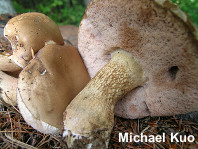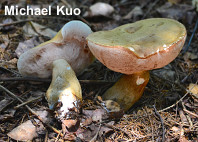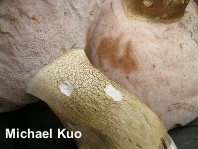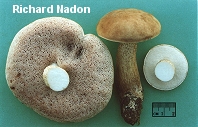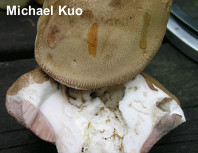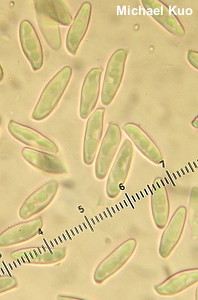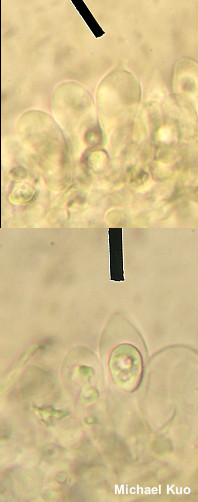| Major Groups > Boletes > Tylopilus > Tylopilus alboater |

|
Tylopilus felleus [ Basidiomycota > Boletales > Boletaceae > Tylopilus . . . ] by Michael Kuo Tylopilus felleus is an impressive, conifer-loving mushroom, distinguished from most other boletes by its substantial and reticulate stem, its extremely bitter taste, its pink pore surface, and its brown to tan colors. It is widely distributed and common east of the Rocky Mountains wherever conifers occur naturally. The "true" Tylopilus felleus is a European species first named from France by Bulliard in 1780. Our North American versions are probably not the same, despite appearances—with the possible exception of specimens associated with naturalized Norway spruce, which is a European tree. Smith & Thiers (1971) created Tylopilus felleus var. uliginosus to account for collections they made in three separate Michigan locations that were "distinguished by the reddish pigment globules in mounts of the hymenophore in Melzer's, in the large globule in the pleurocystidia as revived in KOH, and the terrestrial habitat among lichens and moss on low sandy soil under pines." Since more recent bolete studies (e.g. den Bakker & Noordeloos, 2005) have found the character of red pigment globules in Melzer's, often used taxonomically by Smith & Thiers, to be variable and therefore not informative—and since the presence of refractive globules in hymenial cystidia is, in my experience anyway, a constant variable throughout the boletes—I suspect var. uliginosus is unnecessary. Description: Ecology: Mycorrhizal with conifers; growing alone, scattered, or gregariously; summer and fall; widely distributed east of the Rocky Mountains. The illustrated and described collections are from Pennsylvania, Michigan, and Québec. Cap: 5–13 cm; convex, becoming broadly convex or nearly flat in age; dry; bald and softly leathery; unpolished; sometimes becoming cracked; brown, fading to to tan. Pore Surface: White at first, becoming pink; bruising pinkish brown to brownish; pores circular, 1–2 per mm; tubes to 20 mm deep. Stem: 4–10 cm long; 1.5–4 cm thick; club-shaped; whitish to pale brownish above; pale brown to tan elsewhere; strongly reticulate with a wide-meshed, brown reticulum, at least over upper third; basal mycelium white. Flesh: Thick; soft; white; unchanging when sliced. Odor and Taste: Taste very bitter; odor not distinctive. Chemical Reactions: Ammonia negative to pale orange or pale pink on cap surface; negative on flesh. KOH orangish on cap surface; yellowish to orangish on flesh. Iron salts negative to greenish on cap surface; negative to pale gray on flesh; bluish gray on tubes. Spore Print: Brownish pink. Microscopic Features: Spores 10–16 x 3–4 µm; narrowly fusiform to subfusiform; smooth; hyaline to yellowish in KOH. Hymenial cystidia 30–40 x 8–10 µm; widely fusiform; often developing a mucro; smooth; thin-walled; hyaline in KOH; occasionally with a refractive, golden, globular inclusion. Pileipellis a tangled cutis of cylindric elements REFERENCES: (Bulliard, 1780) Karsten, 1881. (Fries, 1821; Saccardo, 1888; Coker & Beers, 1943; Singer, 1947; Snell & Dick, 1970; Smith & Thiers, 1971; Grund & Harrison, 1976; Smith, Smith & Weber, 1981; Breitenbach & Kränzlin, 1991; Phillips, 1991/2005; Lincoff, 1992; Both, 1993; Barron, 1999; Bessette, Roody & Bessette, 2000; Roody, 2003; McNeil, 2006; Miller & Miller, 2006; Kuo & Methven, 2014.) Herb. Kuo 09050203, 07211404. This site contains no information about the edibility or toxicity of mushrooms. |
© MushroomExpert.Com |
|
Cite this page as: Kuo, M. (2016, June). Tylopilus felleus. Retrieved from the MushroomExpert.Com Web site: http://www.mushroomexpert.com/tylopilus_felleus.html |
